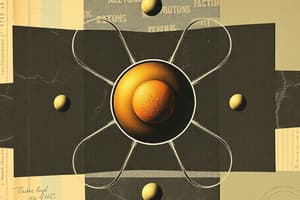Podcast
Questions and Answers
What is the composition of the nucleus of an atom?
What is the composition of the nucleus of an atom?
- Electrons and protons
- Protons and neutrons (correct)
- Only protons
- Neutrons and electrons
What charge do neutrons carry?
What charge do neutrons carry?
- Negative charge
- Equal charge to protons
- No net charge (correct)
- Positive charge
What can be said about the number of protons and electrons in a neutral atom?
What can be said about the number of protons and electrons in a neutral atom?
- There are more electrons than protons
- They can vary independently
- The number is usually equal (correct)
- There are fewer electrons than protons
What is the charge of protons compared to electrons?
What is the charge of protons compared to electrons?
What surrounds the positively charged nucleus of an atom?
What surrounds the positively charged nucleus of an atom?
What is the term used to describe the specific volumes of space that electrons occupy within the electron cloud?
What is the term used to describe the specific volumes of space that electrons occupy within the electron cloud?
What is described as surrounding the central nucleus in an atom?
What is described as surrounding the central nucleus in an atom?
Which statement correctly describes the nature of electrons in the electron cloud?
Which statement correctly describes the nature of electrons in the electron cloud?
Which term describes the central part of an atom?
Which term describes the central part of an atom?
What do the orbitals within the electron cloud represent?
What do the orbitals within the electron cloud represent?
Which types of orbitals can electrons occupy?
Which types of orbitals can electrons occupy?
What determines the energy of an atom?
What determines the energy of an atom?
What is the correct arrangement of orbitals in Shell 2?
What is the correct arrangement of orbitals in Shell 2?
How many types of subshells are mentioned?
How many types of subshells are mentioned?
Which subshell is at the highest energy in Shell 3?
Which subshell is at the highest energy in Shell 3?
Which of the following statements about electron energy is true?
Which of the following statements about electron energy is true?
Which orbital is found in Shell 1?
Which orbital is found in Shell 1?
Which of the following combinations correctly describes Shell 3?
Which of the following combinations correctly describes Shell 3?
What is the correct order of increasing energy for shells?
What is the correct order of increasing energy for shells?
Which subshell exists in Shell 2?
Which subshell exists in Shell 2?
What is the maximum number of electrons that can occupy a single orbital?
What is the maximum number of electrons that can occupy a single orbital?
In which shell does a 3p electron occupy a subshell orbital?
In which shell does a 3p electron occupy a subshell orbital?
What is the correct order in which electrons fill atomic orbitals?
What is the correct order in which electrons fill atomic orbitals?
Which of the following orbital sequences is incorrect according to the building-up principle?
Which of the following orbital sequences is incorrect according to the building-up principle?
How many arrows represent electrons in the s column of Shell 1?
How many arrows represent electrons in the s column of Shell 1?
Which option lists orbitals filled before the 3d orbital?
Which option lists orbitals filled before the 3d orbital?
In the provided information, how are electrons represented?
In the provided information, how are electrons represented?
In what order do the orbitals increase in energy from the given options?
In what order do the orbitals increase in energy from the given options?
Which of the following statements about the d orbital in Shell 3 is correct?
Which of the following statements about the d orbital in Shell 3 is correct?
What is the highest energy level orbital among the following options?
What is the highest energy level orbital among the following options?
What is the electronic configuration of calcium?
What is the electronic configuration of calcium?
Which subshells are occupied by electrons in the third shell of an atom?
Which subshells are occupied by electrons in the third shell of an atom?
What principle explains the distribution of electrons in the orbitals of an atom?
What principle explains the distribution of electrons in the orbitals of an atom?
What does the notation '2p6' signify in an electronic configuration?
What does the notation '2p6' signify in an electronic configuration?
How many total electrons does calcium have in its electronic configuration?
How many total electrons does calcium have in its electronic configuration?
What does Hund's rule state about the filling of orbitals in a subshell?
What does Hund's rule state about the filling of orbitals in a subshell?
Why is an orbital in a subshell not filled completely according to Hund's rule?
Why is an orbital in a subshell not filled completely according to Hund's rule?
In the orbital filling demonstration for the 2p subshell, which configuration represents complete filling according to Hund's rule?
In the orbital filling demonstration for the 2p subshell, which configuration represents complete filling according to Hund's rule?
How many electrons can be present in the 2s orbital after it has fully filled?
How many electrons can be present in the 2s orbital after it has fully filled?
Which statement best illustrates the process of filling orbitals in a subshell according to Hund's rule?
Which statement best illustrates the process of filling orbitals in a subshell according to Hund's rule?
What is defined as the outermost shell of an atom?
What is defined as the outermost shell of an atom?
Which term refers to the electrons that occupy the valence shell?
Which term refers to the electrons that occupy the valence shell?
How does the reactivity of an atom primarily depend?
How does the reactivity of an atom primarily depend?
Which shell is the highest occupied shell for an atom like oxygen?
Which shell is the highest occupied shell for an atom like oxygen?
What occurs during a chemical reaction between atoms?
What occurs during a chemical reaction between atoms?
What is the primary purpose of the redistribution of valence electrons in chemical bonding?
What is the primary purpose of the redistribution of valence electrons in chemical bonding?
According to the octet rule, how many electrons should an atom aim to have in its valence shell?
According to the octet rule, how many electrons should an atom aim to have in its valence shell?
In the provided oxygen shell diagrams, which shell contains the highest number of electrons?
In the provided oxygen shell diagrams, which shell contains the highest number of electrons?
Which statement correctly describes the valence electrons in the completed diagram of oxygen?
Which statement correctly describes the valence electrons in the completed diagram of oxygen?
Which orbitals are only considered for determining valence shells according to the octet rule?
Which orbitals are only considered for determining valence shells according to the octet rule?
Flashcards are hidden until you start studying
Study Notes
Atomic Composition
- Atoms consist of a positively charged nucleus and negatively charged electrons.
- The nucleus contains protons (positive charge) and neutrons (no charge), balancing the atom's overall charge.
- Neutral atoms typically have an equal number of protons and electrons.
Atomic Structure
- Electrons exist in an electron cloud around the nucleus, occupying specific regions called orbitals.
- Orbitals define the probable locations of electrons within the atom.
Atomic Orbitals
- There are four types of orbitals: s, p, d, and f.
- Orbitals are organized into shells, which further divide into subshells indicating energy levels:
- Shell 1: 1s
- Shell 2: 2s, 2p
- Shell 3: 3s, 3p, 3d
- Shell 4: 4s, 4p, 4d
Energy of Atoms
- The energy of an atom corresponds to the energy of its electrons.
- Electron energy is influenced by the orbital occupied.
Electron Filling of Atomic Orbitals
- Pauli Exclusion Principle: Each orbital can hold a maximum of two electrons.
- Building-up Principle: Electrons fill orbitals in increasing energy levels, following the order 1s → 2s → 2p → 3s.
- Hund's Rule: Each orbital in a subshell receives one electron before any orbital is filled completely.
Electronic Configuration
- The electronic configuration describes the distribution of an atom's electrons in its orbitals.
- Example: Calcium (atomic number 20) has the configuration 1s² 2s² 2p⁶ 3s² 3p⁶ 4s².
Valence Shells and Electrons
- The valence shell is the outermost shell of an atom, containing valence electrons that are involved in chemical reactions.
- The reactivity of an atom is determined by its valence electrons and how readily they interact with others.
Chemical Bonds
- Chemical bonds are created through the redistribution of valence electrons.
- Octet Rule: Atoms tend to acquire a full valence shell of eight electrons, primarily considering s and p orbitals.
Example: Oxygen's Electronic Configuration
- In its ground state:
- Shell 1: 1s has 2 electrons.
- Shell 2: 2s has 2 electrons; 2p has 6 electrons.
- When forming bonds, oxygen seeks to complete its valence shell, which influences its participation in chemical reactions.
Studying That Suits You
Use AI to generate personalized quizzes and flashcards to suit your learning preferences.




